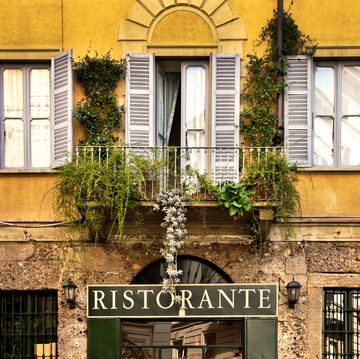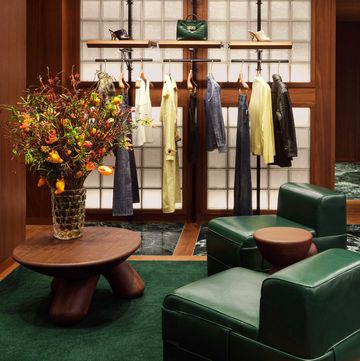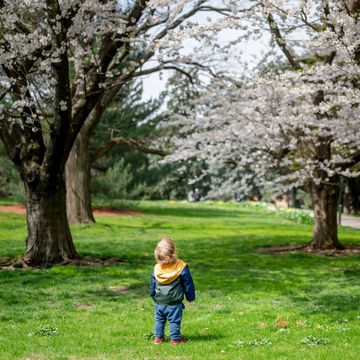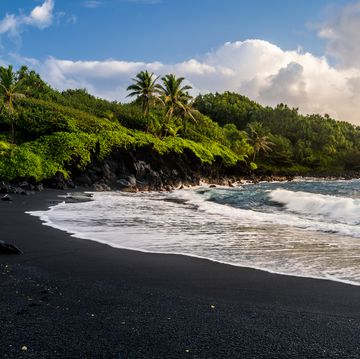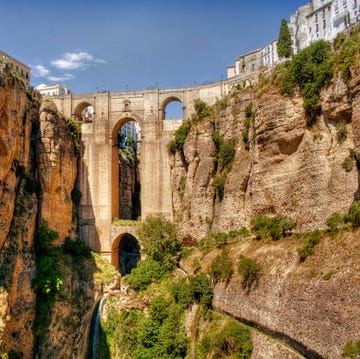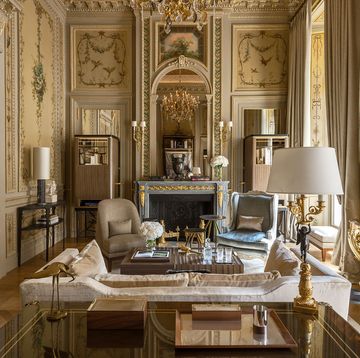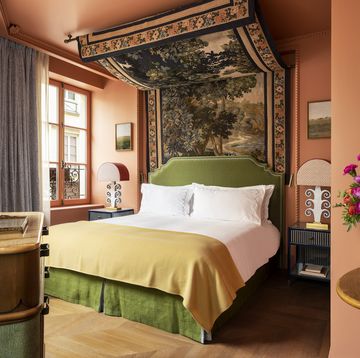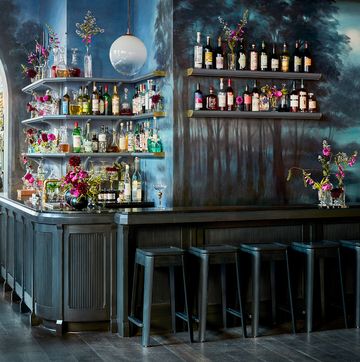Few cities dazzle quite like St. Petersburg, the former imperial capital of Russia. Stucco-faced palaces are painted candied-almond colors. Window frames glitter with gold leaf. And the radiance is magnified as every last czarist morsel is reflected in the sparkling Neva River, in whose icy waters the infamous monk Rasputin finally drowned after having been unsuccessfully poisoned, shot, and clubbed over the course of an evening in 1916.
"Each building is like a monument," says New York–based interior designer Juan Pablo Molyneux. He visits St. Petersburg every few months to connect with ateliers that provide him with marble dust and amber for his projects. "The light is so beautiful, whether it's winter or summer." He also is struck by the melancholy that suffuses this metropolis of nearly five million souls spread across 42 islands and a chunk of mainland: "It has a sadness that I think is quite extraordinary."
Hand-painted china at the Imperial Porcelain Factory.
Photo: Yury Molodkovets
Believe it or not, few people really wanted to come here back in 1712, when Peter the Great moved his court from landlocked medieval Moscow to the then-modern city he had been building since 1703 on a swampy delta hugging the strategic Gulf of Finland. The nobles fought the relocation, just as they fought Peter's insistence that they wear European clothes and shave off their traditional beards. But the czar's will prevailed, and for the next 200-odd years, this was Russia's cosmopolitan center. By the end of the 20th century, however, war, starvation, and benign neglect—as well as multiple name changes, from St. Petersburg to Petrograd to Leningrad to St. Petersburg once more—had taken their toll. But over the past decade, Peter the Great's beloved "window on the West" has been recapturing much of its prerevolutionary perfection.
Most of the country's immense wealth is concentrated in Moscow, the capital since Vladimir Lenin established the government there in 1918, but St. Petersburg "has a certain class that Moscow will never have," Molyneux says. "The people are very different from the people in Moscow," adds Baroness Hélène de Ludinghausen, former director of Yves St. Laurent's couture salons and founder of the nonprofit Stroganoff Foundation, which has funded acclaimed local restorations such as Kazan Cathedral and Stroganoff Palace, Ludinghausen's 18th-century ancestral home. "They are softer and more reserved, but in a nice way," she continues. "There isn't the roughness that you find in Moscow. Even the Russian they speak is prettier."
That elegant reputation is why President Vladimir V. Putin has made the revitalization of his hometown a big part of his program to restore Russia's national pride. Billions of federal rubles were poured into a dramatic cosmetic overhaul of the city, nicknamed Piter by its inhabitants, in time for its 300th anniversary in 2003 and that year's Russia–European Union summit meeting. Konstantinovsky Palace in suburban Strelna, a ruin since it was sacked by Nazi troops during World War II, was completely resurrected. Nearly $300 million and hundreds of traditional craftsmen later, the palace now serves as a venue for high-level government gatherings.
Smolny Cathedral.
Photo: Yury Molodkovets
Last December, St. Petersburg's transition from dowager to dynamo was made complete, as far as the president was concerned. As Putin said upon signing a decree that transferred the Constitutional Court of the Russian Federation from Moscow to a complex of 18th-century buildings here: "We are accustomed to call St. Petersburg our second capital, our northern capital, but before it performed none of the functions of a capital." Thanks to Putin's diktat, it now does.
The eyes of the sailing world will focus on the city next year, when the tenth Volvo Ocean Race winds up just offshore. Oleg Zherebtsov, one of Russia's richest men, is underwriting the country's entry in the nine-month competition and lobbied heavily for the city to be granted the finish-line honors. Founder of the Lenta stores that are the Russian Wal-Mart, Zherebtsov hopes that the race will help to emphasize St. Petersburg's seafaring heritage. "I don't want people to think that all there is here are rich people who spend a lot of money in hotels and restaurants," he says.
With its beautiful Baroque buildings and dozens of curving canals that flow into the Neva, St. Petersburg has rightly been called the Venice of the North. During the so-called White Nights of June and July, when the sun doesn't set, the city is a 24-hour spectacle. Part of this is due to the network of waterways that poet Joseph Brodsky described as providing "such a quantity of mirrors that narcissism becomes inevitable." With so much beauty around, real and reflected, it is no wonder Petersburgers are given to preening. "People feel they built the city themselves," says Semyon Mikhailovsky of the St. Petersburg Academy of Fine Arts. It is a comment that helps explain the concern of some citizens over the country's oil and commodities boom and how it is changing the city.
A room at Taleon Imperial Hotel.
Photo: Yury Molodkovets
Ostentatious displays of new wealth are de rigueur in Russia, and in St. Petersburg, an array of princely settings is available for showing off. A number of distinguished palaces have been turned into restaurants and hotels; others are rented for private parties and splashy masquerade balls "where someone is always dressed as Peter the Great," says Ludinghausen. The sprawling lemon-yellow Yusupov Palace beside the Moika River (Rasputin's last night began there) and the sapphire-blue Catherine Palace—about 14 miles south of the city, in the town of Tsarskoye Selo—are venues favored by the oligarchs, as the headline-grabbing nouveaux riches are known.
Leaders in the arts and design communities worry that the city's breathtaking buildings, its most precious resource, are being compromised by the avalanche of new money. Architect Nikolai Druzin avoids walking past the flashily restored Mikhailovsky Castle, now painted a garish orange. "It was ocher and pink, a very complicated color with nuances, with southern hues like a sunset," says Druzin of the hulking structure, completed in 1801 for Paul I, who was murdered in it later that year. "Now it's vulgar." Decorator Andrei Dmitriev—his interiors are inspired by classical ruins—is of a similar mind and prefers to praise the city's striking but neglected Constructivist buildings, such as the 1934 Lensoviet Palace of Culture. Dmitriev says wistfully, "I constantly dream that I find places in St. Petersburg that are untouched."
Antiques at Marata 10.
Photo: Yury Molodkovets
The latest architectural announcement to alarm preservationists and raise the hackles of UNESCO, which named the city's historic center a world-heritage site, is a 1,300-foot-tall skyscraper that is being planned by Gazprom, the state-controlled natural-gas monopoly. If built, this modern needle will alter the low-rise skyline and overshadow Smolny Cathedral, a 1749 Baroque masterwork by Francesco Bartolomeo Rastrelli, the Italian architect who introduced the frothy style during the reign of Peter the Great's niece Empress Anna. More welcome is architect Norman Foster's redevelopment of the antique warehouses and docks of New Holland, an 18th-century shipbuilding island at the confluence of the Neva and Moika rivers, into a district of theaters, boutiques, art spaces, and more.
An antidote to the glitziness that characterizes so many public spaces patronized by the oligarchs and their consorts is the dining trend of the moment: rooftop restaurants and bars known for their stunning panoramas. Bellevue Brasserie overlooks gargantuan Palace Square and the Winter Palace, the flash point of the October Revolution in 1917. Terrassa, where the beautiful people snack on dim sum, is at eye level with the huge dome of the 1811 Kazan Cathedral, modeled after St. Peter's Basilica. The recently opened Seven Sky Bar offers a view of the Church of the Savior on the Spilled Blood, an onion-domed extravaganza that marks the spot where the serf-emancipating monarch Alexander II was blown apart by an anarchist's bomb in 1881. (In case you haven't noticed already, local history always seems to have a dash of violence.)
The State Hermitage Museum.
Photo: Yury Molodkovets
Restaurateur Leonid Garbar is capitalizing on cultural heritage in a different way. His Stroganoff Steak House, which opened last year, is located in a former horse-guard barrack and is bedecked with historic objects in an interior by design firm Shtab Kvartira, from shining samovars to prerevolutionary advertisements promoting Russian-American business ventures. It has an authenticity that entrepreneurs elsewhere in Russia can only dream about, says Garbar, noting that the Moscow restaurant Turandot is housed in a spectacular 65,000-square-foot St. Petersburg–style palace that reportedly cost $50 million to conjure. Here there is no need to fake a palace. As the restaurateur observes, "You just need to take charge of one."
St. Petersburg is bursting with posh new boutique hotels—Nas Hotel is the most modern—as well as appropriately regal bed-and-breakfasts. Hotels on the grander end of the scale seem to compete for how much gold leaf their designers can trowel on, though none match the refinement of the 19th-century Grand Hotel Europe, which luxury travel company Orient-Express has elegantly revived.
The cluster of islands called Petrogradskaya Storona has become a magnet for dining and shopping with boutiques like Day&Night, a fashion mecca manned by impressively burly security guards. Here too is the new studio and shop of Andrei Ananov, a master of jewels that would have won the admiration of the Romanovs. Speaking of the former imperial family, after you pick up a bauble at Ananov, you can pay your respects to the last czar and his family in nearby Peter and Paul Cathedral. Slaughtered in 1918, Nicholas II, Alexandra, and three of their daughters were interred there in 1998 and canonized by the Russian Orthodox Church. The recently discovered remains of their son and fourth daughter may soon join them.
St. Petersburg set the style in imperial times, so it is promising to note that the archipelago is back on the fashion map. Encouraged by the rise of homegrown frock stars like Vladimir Bukhinnik and the catwalks of Fashion Week, now in its eighth year, insiders suggest that innovative clothing might make this city the next Antwerp. Native daughter Alena Akhmadullina, Russia's fashion eminence, now lives amid the oligarchs of Moscow, though she insists her soul is here. After all, as any Russian can tell you, St. Petersburg is where the beauty is.

